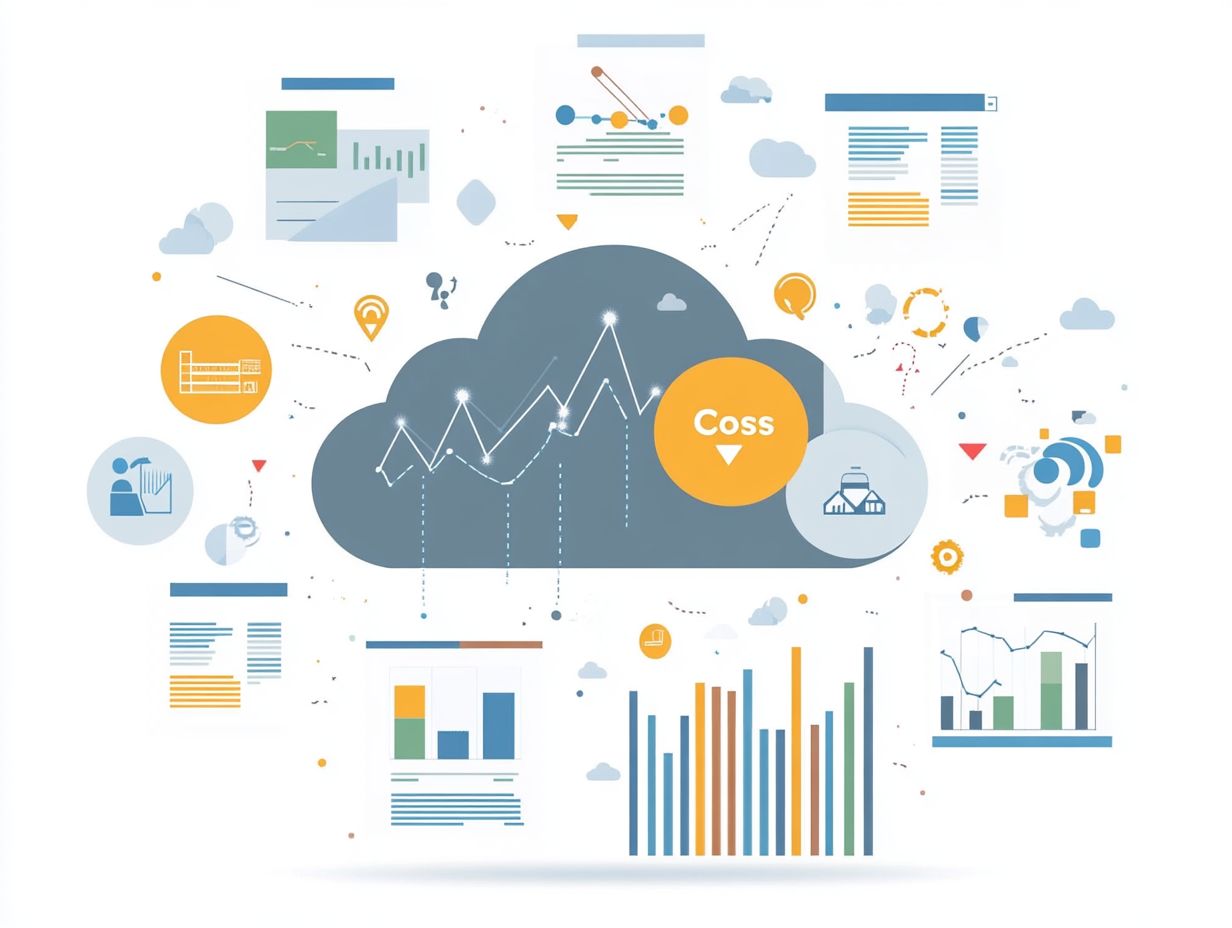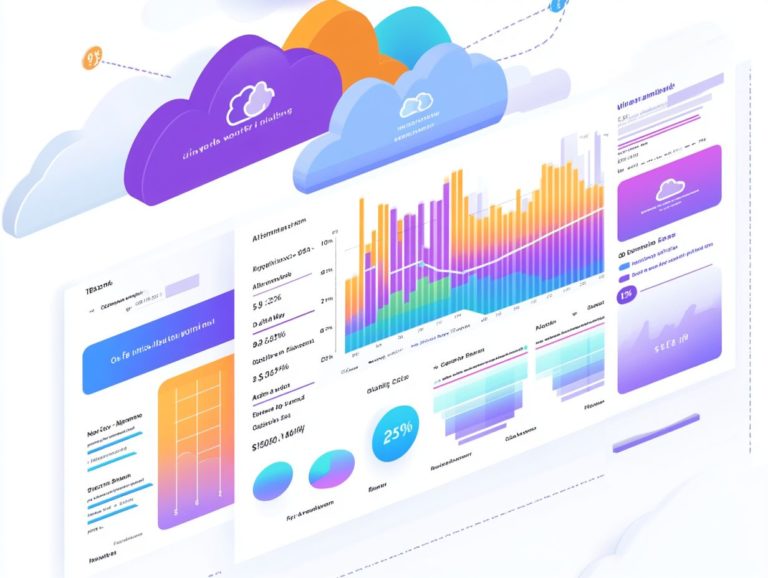Cloud Cost Allocation: What You Need to Know
In today’s digital landscape, effectively managing cloud costs is essential for businesses of all sizes. Understanding cloud cost allocation not only aids in budgeting but also enhances resource utilization and strategic planning.
This article will help you discover the definition and significance of cloud cost allocation, exploring the key factors that influence costs and examining various allocation methods. Don’t miss out on essential strategies that can save your business money!
You’ll also uncover common challenges and their solutions, along with best practices for efficient cost management.
Dive in to discover insights that can truly optimize your cloud spending!
Contents
Key Takeaways:

- Understand the importance of cloud cost allocation in managing expenses and optimizing resources.
- Monitor usage patterns, third-party services, and add-ons when determining cloud costs.
- Use different methods and tools while following best practices to effectively allocate and manage cloud costs.
Understanding Cloud Cost Allocation
Understanding cloud cost allocation is essential for any organization aiming to unlock the full potential of its cloud investments, particularly when leveraging platforms like AWS, Azure, or GCP. This process entails assigning costs to specific resources, which maintains financial accountability and enhances cost visibility throughout your entire cloud infrastructure.
By adopting effective tagging strategies, which help label cloud resources to track costs effectively, and utilizing robust cost allocation models, you can gain valuable insights into shared costs reporting.
This, in turn, facilitates better financial planning, ultimately leading to optimized resource usage and reduced expenses.
Definition and Importance
Cloud cost allocation is an organized way to distribute cloud expenses across various departments or projects, enhancing financial accountability and empowering your decision-making process. For more insights, check out cloud cost management: a beginner’s guide.
By meticulously tracking and attributing these costs, your organization can uncover vital insights into cloud spending patterns, leading to more informed budgeting and resource allocation.
For example, when you assess cloud expenses by project, you might discover excessive spending in a certain area, prompting a necessary review of resource usage. This level of visibility encourages accountability among your teams and aids in optimizing overall cloud expenditures.
Tools like AWS Cost Explorer are essential in this framework. They provide visualizations and analytics that illuminate spending trends, making it simpler for management to implement necessary adjustments and foster a culture of financial responsibility throughout the organization.
Key Factors Affecting Cloud Costs
Grasping the key factors that influence cloud costs is essential for any business striving to optimize its expenditures and resource allocation, especially on platforms like AWS, Azure, and GCP.
Usage patterns are pivotal as they reveal how various resources are consumed and significantly impact your overall cloud expenses. Data transfer costs are another important factor to monitor, as they can escalate rapidly if not managed with care.
Lastly, consider the types of services you utilize and the charges associated with them, as they all contribute to the financial landscape of your cloud journey.
Usage Patterns and Resource Allocation

Usage patterns in cloud environments offer valuable insights into how you allocate and consume resources, significantly influencing your overall cloud costs. By thoroughly analyzing these patterns, you can uncover trends and anomalies in resource usage, empowering you to make informed decisions about your infrastructure.
For instance, using tools like AWS Cost Explorer allows you to visualize your spending and usage data in real-time, helping you identify areas where resources may be underutilized or over-provisioned. This visibility enables you to make strategic adjustments, such as downsizing instances or reallocating budget towards more critical workloads, ultimately leading to considerable cost savings.
Incorporating this analysis into your regular financial reviews fosters a culture of efficiency and accountability across your teams.
Third-Party Services and Add-ons
Third-party services and add-ons can improve the functionality of your cloud solutions. However, they also have the potential to inflate your cloud expenses if not monitored diligently.
You might be taken aback by the additional costs that arise from these external tools, including licensing fees, usage charges, and even integration costs.
Hidden charges can affect your budget. It s essential to be proactive.
To effectively manage and integrate these services, it s crucial to establish clear usage guidelines and conduct regular audits to scrutinize your spending patterns.
Implementing automated monitoring tools can also be beneficial. These tools help you pinpoint unexpected charges and ensure that the influence of third-party services on your cloud costs stays well within acceptable limits.
Methods of Cloud Cost Allocation
You can explore a range of cloud cost allocation methods to elevate financial accountability and refine resource management. You ll find this approach works wonders when you implement tagging strategies and cost allocation models tailored to your organization’s unique requirements.
Tagging strategies involve labeling resources to track costs effectively. By leveraging AWS resource tags, you can categorize and monitor your cloud expenditures with greater efficiency, setting the stage for robust cost management and enhancing decision-making.
Different Approaches and Tools
You have various approaches and tools at your disposal for cloud cost allocation, empowering you to manage and optimize your cloud expenses effectively.
Among these tools, AWS Cost Explorer truly shines as a formidable option. It allows you to visualize your spending patterns and uncover trends over time.
By leveraging this tool, you can delve deep into your expenditures, breaking them down by accounts, services, and even tags, enabling precise tracking of your resource usage.
Consider specific cost allocation models like the unidimensional model, which simplifies expense tracking for individual services, or the multidimensional model, ideal for those using multiple cloud services. These models enhance financial accountability and pave the way for smart budgeting, ensuring that every dollar you spend aligns seamlessly with your business objectives.
Challenges and Solutions

You might run into challenges with cloud cost allocation that can impede financial accountability and obscure your understanding of cloud expenses. However, these challenges can be effectively addressed through strategic solutions.
You might face these common obstacles:
- Inconsistencies in tagging
- Difficulties in tracking resource usage
- Inadequate reporting of shared costs
Each of these issues complicates your grasp of cloud expenditures, making it essential to implement a robust approach to manage and clarify your financial landscape.
Common Obstacles and How to Overcome Them
Common obstacles in cloud cost allocation often stem from tag inconsistency and insufficient reporting of shared costs, significantly undermining financial accountability.
These challenges can distort your financial insights, making it challenging to track where your cloud spending is headed effectively.
To address tag inconsistency, implement a standardized tagging policy across all departments to ensure uniform labeling for easy tracking. Embracing automated tools will streamline this process and enhance efficiency.
For shared costs, adopting effective reporting mechanisms that break down expenses based on usage will offer much-needed clarity. Regular audits of these reports can help refine your allocation methods and bolster financial oversight.
Best Practices for Cloud Cost Allocation
Implementing best practices for cloud cost allocation is crucial for organizations aiming to master effective cost management and bolster their accountability strategies, especially within the intricate terrain of multi-cloud environments like AWS, Azure, or GCP.
By following established guidelines, you can elevate your financial planning, enhance resource visibility, and optimize your cloud expenditures. Ensure that every dollar is well spent.
Start implementing these practices today to take control of your cloud costs!
Tips for Effective Cost Management
Effective cost management requires a proactive approach, adding clear rules for accountability that enhance transparency and ensure optimal resource use within cloud environments.
To achieve this, regularly monitor your usage patterns and use tools that provide real-time insights into your spending. Clear policies for resource allocation are crucial; they help you avoid over-provisioning and unnecessary costs.
Regular audits can uncover hidden savings waiting to be tapped! These audits can reveal unused or underutilized resources, allowing you to optimize your cloud footprint effectively.
By creating a culture of ownership among your team regarding their cloud usage, you can inspire smarter decision-making, leading to significant savings and improved financial performance in your cloud operations. Start optimizing your cloud costs today for better savings tomorrow!
Frequently Asked Questions

What is cloud cost allocation?
Cloud cost allocation is the process of attributing and distributing the costs associated with using cloud services to specific departments, teams, or projects within an organization.
Why is cloud cost allocation important?
Cloud cost allocation is important because it allows organizations to accurately track and manage their cloud expenses, identify areas for cost optimization, and understand cloud resource allocation to the appropriate stakeholders.
What factors should be considered when allocating cloud costs?
- The type and amount of cloud services used
- The time period in which they were used
- The specific departments or teams utilizing the services
How can cloud cost allocation help with budgeting?
By accurately allocating costs to different departments or projects, cloud cost allocation helps organizations better understand their cloud spending and make more informed budget decisions for future cloud usage.
Are there tools available to assist with cloud cost allocation?
Yes, many tools and services can help with cloud cost allocation, such as cloud management platforms, cost optimization tools, and reporting and analytics solutions.
Can cloud cost allocation be automated?
Yes, cloud cost allocation can be automated using various tools and services, helping to streamline the process and ensure accurate cost allocation regularly.





